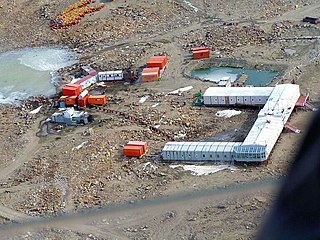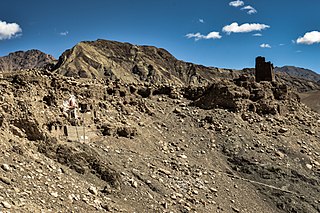Related Research Articles

Dakshin Gangotri was the first scientific base station of India situated in Antarctica, part of the Indian Antarctic Programme. It is located at a distance of 2,500 kilometres (1,600 mi) from the South Pole. It is currently being used as a supply base and transit camp. The base is named after Dakshin Gangotri Glacier.

Maitri, also known as Friendship Research Center is India's second permanent research station in Antarctica as part of the Indian Antarctic Programme. The name was suggested by the then Prime Minister of India Mrs. Indira Gandhi. Work on the station was first started by the Indian Expedition which landed there in end Dec 1984, with a team led by Dr. B. B. Bhattacharya. Sqn Ldr D. P. Joshi, the surgeon of the team, was the first camp commander of the tentage at camp Maitri. The first huts were started by the IV Antarctica Expedition and completed in 1989, shortly before the first station Dakshin Gangotri was buried in ice and abandoned in 1990–91. Maitri is situated in the rocky mountainous region called Schirmacher Oasis. It is only 5 km away from the Russian Novolazarevskaya Station.

The Siachen Glacier is a glacier located in the eastern Karakoram range in the Himalayas at about 35.421226°N 77.109540°E, just northeast of the point NJ9842 where the Line of Control between India and Pakistan ends. At 76 km (47 mi) long, it is the longest glacier in the Karakoram and second-longest in the world's non-polar areas. It falls from an altitude of 5,753 m (18,875 ft) above sea level at its head at Indira Col on the India–China border down to 3,620 m (11,875 ft) at its terminus. The entire Siachen Glacier, with all major passes, has been under the administration of India since 1984. Pakistan maintains a territorial claim over the Siachen Glacier and controls the region west of Saltoro Ridge, lying west of the glacier, with Pakistani posts located 3,000 ft below more than 100 Indian posts on the ridge.

The Indian Astronomical Observatory (IAO), located in Hanle near Leh in Ladakh, India, has one of the world's highest located sites for optical, infrared and gamma-ray telescopes. It is operated by the Indian Institute of Astrophysics, Bangalore. It is currently the ninth highest optical telescope in the world, situated at an elevation of 4,500 meters (14,764 ft).

Nubra is a subdivision and a tehsil in the Indian union territory of Ladakh. Its inhabited areas form a tri-armed valley cut by the Nubra and Shyok rivers. Its Tibetan name Ldumra means "the valley of flowers". Demands have been raised and BJP has hinted at creation of Nubra as a new district. Diskit, the headquarters of Nubra, is 120 km north from Leh, the capital of Ladakh.

The Saltoro Mountains are a subrange of the Karakoram Range. They are located in the southeast Karakoram on the southwest side of the Siachen Glacier, one of the two longest glaciers outside the polar regions. The name given to this range is shared with the Saltoro Valley which is located to the west of this range, downslope on the Pakistan side of the Saltoro Range which generally follows the Actual Ground Position Line. Saltoro Kangri peak, Saltoro River, and Saltoro Valley are features on this range. The Actual Ground Position Line (AGPL) between Indian and Pakistan held area runs through this range, where the high peaks and passes of the Siachen area are held by India, whereas Pakistan occupies the lower peaks and valleys to the west.

Ghent Kangri is a high peak near the north end of the Saltoro Mountains, a subrange of the Karakoram range. It is located west of the Siachen Glacier near the Actual Ground Position Line between India and Pakistan.

Tourism is one of an economic contributor to the union territory of Ladakh in Northern India. The union territory is part of the broader disputed Kashmir region and is sandwiched between the Karakoram mountain range to the north and the Himalayas to the south and is situated at the height of 11,400 ft. Ladakh is composed of the Leh and Kargil districts. The region contains prominent Buddhist sites and has an ecotourism industry. As of 2020, tourism industry in Ladakh was worth ₹600 crore (US$84 million).

Daulat Beg Oldi is a traditional campsite and current military base located in the midst of the Karakoram Range in northern Ladakh, India. It is on the historic trade route between Ladakh and Central Asia, forming the last campsite before reaching the Karakoram Pass. It is said to be named after Sultan Said Khan, who died here on his return journey after an invasion of Ladakh and Kashmir. Chip Chap River, the main headwater of the Shyok River, flows just to the south. The Line of Actual Control with Chinese-controlled Aksai Chin is 5 miles to the east.

Thoise or Thoise Airbase is a military airfield and small village in Nubra region of Ladakh, India, occupying the only large piece of flat land in the area. The airstrip is a critical facility enabling a quick inflow of men and material from the Indian interior to Siachen, a glacier, helipad and battleground near the Actual Ground Position Line between India and Pakistan.

Siachen Base Camp, 12,000 feet above sea level at Partapur, is a base camp of 102 Infantry Brigade of XIV Corps of Indian Army which protects 110 km long Actual Ground Position Line (AGPL) with at least 108 forward military outposts and artillery observation posts in the disputed region of Siachen Glacier in Ladakh Union Territory of India. It is approximately 6 hours drive north from the town of Leh via one of the highest vehicle-accessible passes in the world, Khardung La at 17,582 feet. Bana Top is the highest post in the region, an 80 km and 20 day trek for troops. Pahalwan Post and posts near Indira Col are other high posts. Kumar Post or Kumar Base, which serves as the battalion head quarter, is named after the Colonel Narendra "Bull" Kumar and it is 60 km from the Siachen base towards Indira Col. The Siachen brigade consists of five to eight battalions of Ladakh Scouts supported by artillery, air defence, engineer and other logistic units. Pakistan has not been able to scale the crest of the Saltoro Range occupied by India. The temperature goes down to minus 86°C during winters with icy 300 kmph blizzards. The average temperature is between minus 25°C during day and minus 55°C during the night.
XIV Corps or Fire and Fury Corps is a corps of the Indian Army. It is a part of the Army's Udhampur-based Northern Command. The 14 Corps looks after military deployment along Kargil-Leh and looks after the frontiers with China, Pakistan and also guards the Siachen Glacier.

The Actual Ground Position Line (AGPL) divides current positions of Indian and Pakistani military posts and troops across the entire 110 kilometres (68 mi) long front line in the disputed region of Siachen Glacier. AGPL generally runs along the Saltoro Mountains range, beginning from the northernmost point of the (LOC) at Point NJ 9842 and ending in the north on the Indira Ridge at the India-China-Pakistan LAC tripoint near Sia Kangri about 4 km northwest of Indira Col West, with peaks in excess of 7,000 meters and temperatures ranging to around minus 55 celsius. India gained control of 1,000 square miles (2,600 km2) of disputed territory in 1984 because of its military operations in Siachen. A cease-fire was announced in 2003.

Indira Col West is a mountain pass at 5,988 metres (19,646 ft)) altitude on the Indira Ridge of Siachen Muztagh in Karakoram Range. It is on the border between Indian-controlled Siachen Glacier and the Chinese-controlled Trans-Karakoram Tract, close to the tripoint of India, Pakistan, and China. The India-Pakistan Actual Ground Position Line (AGPL) in the Siachen area ends near the pass. It is possible to ascend the pass from both the north and south sides controlled by China and India respectively.

Bharati is a permanent Antarctic research station commissioned by India. It is India's third Antarctic research facility and one of two active Indian research stations, alongside Maitri. India's first committed research facility, Dakshin Gangotri, is being used as a supply base. India has demarcated an area beside Larsemann Hills at 69°S, 76°E for construction. The research station has been operational since 18 March 2012, though it is still being run on trial basis and formal launch is awaited. Since its completion, India has become one of nine nations to have multiple stations within the Antarctic Circle. Bharati's research mandate focuses on oceanographic studies and the phenomenon of continental breakup. It also facilitates research to refine the current understanding of the Indian subcontinent's geological history. News sources have also referred to the station as "Bharathi", "Bharti" and "Bharati".

Brahma Singh is an Indian Horticultural scientist, known for his expertise on protected cultivation and his efforts in developing agro-technologies for the high altitude areas of the Himalayan region of Leh and for identifying and popularizing the fruit crops of seabuckthorn and Indian mulberry (Noni). The Government of India honoured him, in 2014, by awarding him the Padma Shri, the fourth highest civilian award, for his contributions to the fields of science and technology.

Saspol Caves are situated in the hills behind Saspol, Ladakh, India, which is about 76 km from the city centre of Leh. Paintings exist in five caves, two of them extensively damaged. One of the painted caves, that have been given a coat of lime wash and red paint in the exterior is the most visited and is considered as the main cave. Paintings of Anuttarayoga Tantra images of the main cave is very rare during the period of execution of these paintings. These caves are under the administration of Lekir Monastery.
The Defence Research Laboratory (DRL) is a defence laboratory of the Defence Research and Development Organisation (DRDO) located in Tezpur city of Assam state of India. It conducts research and development studies on vector-borne diseases, improving the quality of drinking water, waste biodegradation and management.
The Defence Institute of Bio-Energy Research (DIBER) is an Indian defence laboratory of the Defence Research and Development Organisation (DRDO). Located in Haldwani in Uttarakhand state. It conducts research and development of bioenergy as well as the sustainable and eco-friendly high altitude agro-technologies in the Indian Himalayan Region for the use of Indian Military. It has developed a range of vegetable varieties suitable for mid to high altitude.

Ritesh Arya is an Indian geologist known for finding water at multiple locations in the high-altitude cold and mountainous desert of Ladakh, including the Siachen Glacier, which has made him a Guinness World Records holder. In 2014 he was Director Water and Geothermal Section at the International Sustainable Energy Organization (ISEO).
References
- ↑ DRDO to become leaner and more focused on futuristic technology, The Week, 25 April 2021.